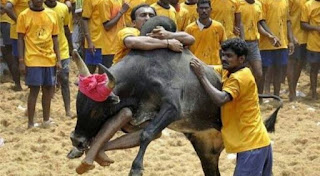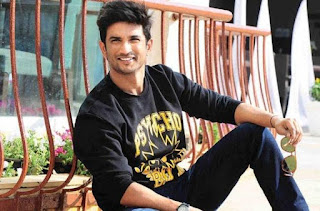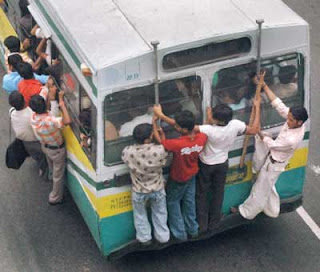Victory Of Jallikattu
Being a North Indian, I myself was unable to understand the imporatnce or I can say need of this sport. I have never witnessed any bull taming event and I don't know whether I want to see it in my future or not.
But, after seeing massive support of Tamil people for this sport, It forced me to understand the perspective of Jallikattu.
Jallikattu has been known to be practiced during the Tamil Classic Period (400-100 BC). It was common among the ancient people Aayars who lived in the ‘Mullai’ geographical division of the ancient Tamil country. Later, it became a platform for display of bravery and prize money was introduced for participation encouragement. It is a traditional sport in which a Bos indicus bull (Kangayam breed) is released into a crowd of people. Participants attempt to grab the large hump of the bull with both arms and hang on to it while the bull attempts to escape. Participants hold the hump for as long as possible, attempting to bring the bull to a stop. In some cases, participants must ride long enough to remove flags on the bull's horns.
Wooh, It gave me goosebumps by just going through the introduction of this sport. If It can be so dangerous then why all of them are still supporting it? I was eager to know about this.

How it started?
After hearing the petitions which were led by the Animal Welfare Board of India challenging central government's notification the Supreme Court of India on 12 January 2017 ordered a stay, issued notices to the central government and Tamil Nadu Governmentand later refused to lift the stay.
Why is there so much opposition to jallikattu?
Why ban Jallikattu?
There may be several reasons for the ban of this sport but the main reasons is injury.
If we analyze the media reports throughly, we will observe that they have highlighted only about the injuries caused due to this sport.
I am not blaming media but the way they have been representing the facts of jallikattu to the people has created a different mindset among the people about its cruelity which is not true. They just want to display any sensational news and eyegrabbing news just to increase their TRP.
If Jallikattu is to be banned then we should think about banning these sports too -
1. Cricket - Phillip J. Hughes, was struck in the neck by the ball after missing a shot. He was wearing a helmet, but the ball struck an unprotected area just below his left ear and after surgery he died.
Ball can be dangerous. BAN CRICKET!
2. Kite Festival - All of us love flying kite during August, specially on 15th Aug, to celebrate Inependence day. But the day after 15 Aug, we come across the news that number of kids are injured or met to death after falling from their terrace. BAN IT.
Why we should not ban Jallikattu?
There is a misconception that Jallikattu and Spanish bull fighting is common. But it's not true. Jallikattu is not about injuring the bull, It's about taming the bull, embracing the bull.
The petition filed by PETA by saying that cruelty is meted out to animals by giving them alcohol, prodding and twisting their tails, organisers beat the bulls, stuffing something pungent in their nostrils, confine them in a dark, suffocating place in order to enrage them is just rubbish. If you go through any article about how this sport is played, you will understand the different aspects of this sport.
About the Breeds
There were 100+ cattle breeds in India 100 years ago and now there are only 30+. Unless we engage with the traditional livestock keepers and support them, we will lose these breeds as well as lay the ground for commercial cattle based dairies and slaughter houses to dominate the country.
Tamil Nadu had six cattle breeds earlier and now we have lost the Alambadi breed. The remaining breeds are Kangayam, Pulikulam, Umbalachery, Barugur and Malai Maadu. Kangayams (polular for Jallikattu) fed on grasses in the calcium rich soil are the sturdiest animals and can pull up to 2.5 times their body weight with ease.
One main reason behind the protest is to save breeds of our nation.
#Save_Jallikattu #Save_breeds
What we should learn from our Tamil brothers?
So, we have seen that Jallikattu has been went through numerous ups and down. And this protest settled down with a vicotry. There is a great message behind this act. Though we are still puzzled with religion, caste etc. But people of Tamil Nadu has set an example "Rise above religion, Rise above caste"
No violence- A peaceful protest. No harm to the government property, no harm to the traffic and last not the least *No Band* (As we have witnessed Bharat band, Delhi band). People of Tamil Nadu deserves a huge round of applause. As I have been there for a few months. Their culture , way of living, their mindset, thinking is far better than some of those coward politicians who believes in split and rule on the basis of caste and religion. All those Nobel prizes in India has been awarded to intelligent South Indian people. I know there is a gap in between North Indians and South Indian people. But, Tamil Nadu has shown a path to eliminate this gap. "Power of unity". We cannot bring any change until we unite. If we need to bring any change, we have to unite ourselves.
It's not only Jallikattu's victory or Tamil Nadu's victory, It is the victory of India.
"Unity brings development
Development eradicates poverty"
But, after seeing massive support of Tamil people for this sport, It forced me to understand the perspective of Jallikattu.
Jallikattu has been known to be practiced during the Tamil Classic Period (400-100 BC). It was common among the ancient people Aayars who lived in the ‘Mullai’ geographical division of the ancient Tamil country. Later, it became a platform for display of bravery and prize money was introduced for participation encouragement. It is a traditional sport in which a Bos indicus bull (Kangayam breed) is released into a crowd of people. Participants attempt to grab the large hump of the bull with both arms and hang on to it while the bull attempts to escape. Participants hold the hump for as long as possible, attempting to bring the bull to a stop. In some cases, participants must ride long enough to remove flags on the bull's horns.
Wooh, It gave me goosebumps by just going through the introduction of this sport. If It can be so dangerous then why all of them are still supporting it? I was eager to know about this.

How it started?
- The Animal Welfare Board of India filed a case in the Supreme Court of India for an outright ban on Jallikattu because of the cruelty to animals and the threat to public safety involved.
- On 27 November 2010, the Supreme Court permitted the Government of Tamil Nadu to allow Jallikattu for five months in a year and directed the District Collectors to make sure that the animals that participate in Jallikattu are registered to the Animal Welfare Board and in return the Board would send its representative to monitor the event.
- The Ministry of Environment and Forests issued a notification in 2011 that banned the use of bulls as performing animals, thereby banning the event.But the practice continued to be held under Tamil Nadu Regulation of Jallikattu Act No 27 of 2009.On 7 May 2014, the Supreme Court of India struck down the state law and banned Jallikattu altogether. The Supreme Court noted that any flouting of the ban should result in penalties for cruelty to animals under The Prevention of Cruelty to Animals Act, 1960.
- In May 2014, the Supreme Court of India banned the practice, citing animal welfare issues. On 8 January 2016, the Government of India passed an order exempting Jallikattu from all performances where bulls can not be used, effectively reversing the ban. However, on 14 January 2016, the Supreme Court of India upheld its ban on the event, leading to protests all over Tamil Nadu.
- On 16 January 2016, the World Youth Organization protested at Chennai against the stay on ban on conducting Jallikattu in Tamil Nadu. WYO also demanded a ban on PETA in India.
- On 8 January 2017, some anonymous groups conducted a well organized rally at Chennai Marina opposing the ban on Jallikattu.The participants walked from the lighthouse to labour statue bearing posters saying ‘save Jallikattu'. It is reported that there were thousand of participants in the rally. Given the well-planned nature nature of the agitations its vivid that several Christian NGOs are involved in fueling the agitation among the public.
 |
| A supporter supporting Jallikattu |
Why is there so much opposition to jallikattu?
Why ban Jallikattu?
There may be several reasons for the ban of this sport but the main reasons is injury.
If we analyze the media reports throughly, we will observe that they have highlighted only about the injuries caused due to this sport.
I am not blaming media but the way they have been representing the facts of jallikattu to the people has created a different mindset among the people about its cruelity which is not true. They just want to display any sensational news and eyegrabbing news just to increase their TRP.
If Jallikattu is to be banned then we should think about banning these sports too -
1. Cricket - Phillip J. Hughes, was struck in the neck by the ball after missing a shot. He was wearing a helmet, but the ball struck an unprotected area just below his left ear and after surgery he died.
Ball can be dangerous. BAN CRICKET!
2. Kite Festival - All of us love flying kite during August, specially on 15th Aug, to celebrate Inependence day. But the day after 15 Aug, we come across the news that number of kids are injured or met to death after falling from their terrace. BAN IT.
Why we should not ban Jallikattu?
There is a misconception that Jallikattu and Spanish bull fighting is common. But it's not true. Jallikattu is not about injuring the bull, It's about taming the bull, embracing the bull.
The petition filed by PETA by saying that cruelty is meted out to animals by giving them alcohol, prodding and twisting their tails, organisers beat the bulls, stuffing something pungent in their nostrils, confine them in a dark, suffocating place in order to enrage them is just rubbish. If you go through any article about how this sport is played, you will understand the different aspects of this sport.
About the Breeds
There were 100+ cattle breeds in India 100 years ago and now there are only 30+. Unless we engage with the traditional livestock keepers and support them, we will lose these breeds as well as lay the ground for commercial cattle based dairies and slaughter houses to dominate the country.
Tamil Nadu had six cattle breeds earlier and now we have lost the Alambadi breed. The remaining breeds are Kangayam, Pulikulam, Umbalachery, Barugur and Malai Maadu. Kangayams (polular for Jallikattu) fed on grasses in the calcium rich soil are the sturdiest animals and can pull up to 2.5 times their body weight with ease.
One main reason behind the protest is to save breeds of our nation.
#Save_Jallikattu #Save_breeds
What we should learn from our Tamil brothers?
So, we have seen that Jallikattu has been went through numerous ups and down. And this protest settled down with a vicotry. There is a great message behind this act. Though we are still puzzled with religion, caste etc. But people of Tamil Nadu has set an example "Rise above religion, Rise above caste"
No violence- A peaceful protest. No harm to the government property, no harm to the traffic and last not the least *No Band* (As we have witnessed Bharat band, Delhi band). People of Tamil Nadu deserves a huge round of applause. As I have been there for a few months. Their culture , way of living, their mindset, thinking is far better than some of those coward politicians who believes in split and rule on the basis of caste and religion. All those Nobel prizes in India has been awarded to intelligent South Indian people. I know there is a gap in between North Indians and South Indian people. But, Tamil Nadu has shown a path to eliminate this gap. "Power of unity". We cannot bring any change until we unite. If we need to bring any change, we have to unite ourselves.
It's not only Jallikattu's victory or Tamil Nadu's victory, It is the victory of India.
"Unity brings development
Development eradicates poverty"



Comments
Post a Comment